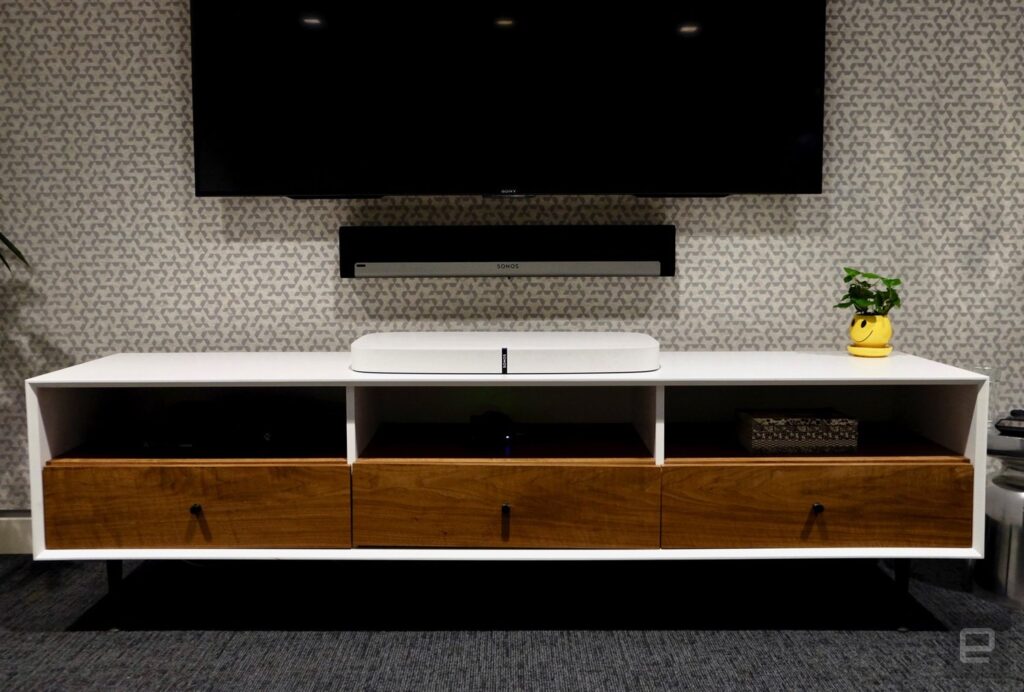About Sound Bar Mounting
When mounting a soundbar to your TV at TV Mounting Dallas, there are several important considerations you must make to ensure that the installation is properly done. First and foremost, you need to make sure the soundbar is compatible with your television set and mount. This will involve measuring your TV’s exact width and height as well as selecting a mount which will be able to support its weight without fail.
Additionally, it is essential that the wall where the soundbar will be mounted is structurally sound enough for the installation. It is imperative that screws be placed correctly in solid wood or masonry walls; any thin sheetrock or plaster may not provide enough support for the soundbar and could result in serious damage if installed incorrectly.
Once you have found a compatible mount and have confirmed that your wall can handle it safely, you should also consider where on your wall you want to place your sound bar. This decision should be based on several factors such as aesthetics, interference from other electronics or appliances in the room, and acoustics of the space itself. Ultimately, finding just the right placement of your sound bar will help ensure an optimal listening experience while avoiding various issues such as buzzing or interference from other sources.
Finally, when mounting a soundbar at any TV Mounting Dallas service provider, it is important that all instructions provided by the manufacturer are followed exactly; failure to do so could lead to installation errors which could potentially affect both performance and safety of your system. That said, if done correctly professional installation of a sound bar can add greatly to both viewing pleasure and audio quality in any given home theater setup.
When considering the mounting options for a sound bar, it is important to consider the size and weight of the sound bar, as well as the space available. Wall-mounting a sound bar allows for optimal placement for sound quality as well as maximum convenience since it eliminates the need for extra cable clutter.
Advanttage of Wall Mounting
Though wall-mounting offers many advantages, homeowners should consider any obstructions that may affect performance. For example, if mounting on a brick or concrete wall, be sure you have the correct anchors and fasteners to secure your soundbar mount. If you do not have access to anchors and fasteners, you may be able to use an adhesive foam tape which provides enough strength for smaller sound bars under 10 lbs.
Before drilling any holes in your walls, make sure to measure twice and mark where each anchor will go. This will help ensure that you accurately mount your sound bar in its optimal position with no obstructions or interference from other objects nearby. Keep in mind that some mounts are designed specifically for accommodating certain types of wall materials, so make sure yours is appropriate before purchasing.
In addition to traditional wall-mounting options, some newer models offer different mounting methods such as ceiling mounts or speaker stands that can also provide excellent audio quality depending upon your specific needs and preferences. Make sure to research different methods thoroughly before committing to one so that you can get the best results possible depending upon your situation.
Mounting a sound bar is not as daunting of a task as it may seem. It requires knowledge of the space and the sound bar itself, but with a little preparation, mounting a sound bar can be done quickly and easily.
When preparing to mount your sound bar, there are several key considerations.
Measure the area
First, measure the area where you plan to install the soundbar so that you can determine what size will fit – many
soundbars are adjustable in size and can accommodate different lengths of wall space. Additionally, if there is an accompanying subwoofer or other components, consider their size when selecting placement for the soundbar.
Type of mounting hardware
Secondly, research the type of mounting hardware that will best support your system; most sound bars come with their own mounting bracket or wall-mounting system that should be used for optimal security and stability. As for installation itself, it may help to have another person to safely lift and hold the components in place during setup.
Mounting can involve drilling holes into walls if using screws or anchors for secure placement, so it’s important to make sure you know where electrical wires lie behind drywall before attempting this step. When drilling, use caution and always wear protective eyewear while doing any kind of work involving power tools.
Ensure that all connections
Lastly, ensure that all connections between components are secure and properly connected before fully completing installation – loose connections could lead to static-like noises coming from your surround-sound system or other audio malfunctions down the road. Once you have completed installation and everything is connected securely, enjoy your newly mounted home theater!

